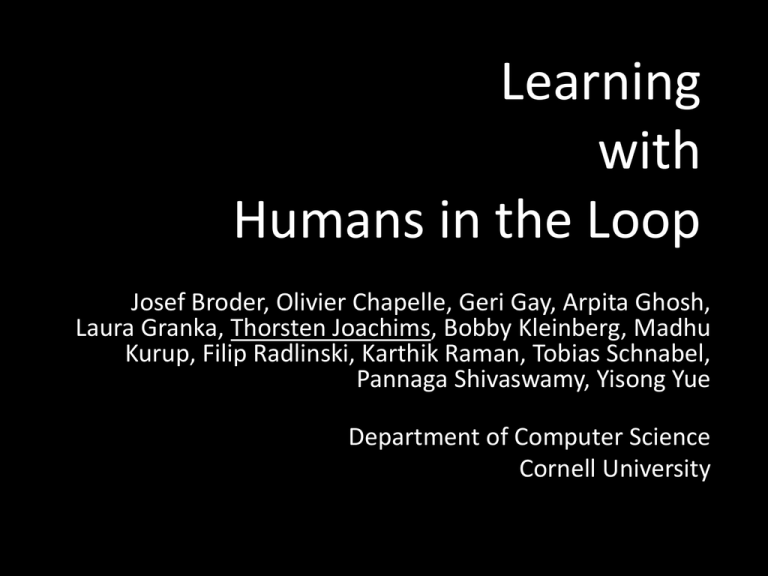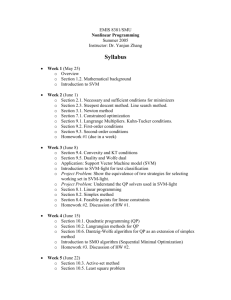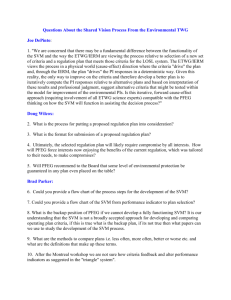Indexing and Preprocessing
advertisement

Learning
with
Humans in the Loop
Josef Broder, Olivier Chapelle, Geri Gay, Arpita Ghosh,
Laura Granka, Thorsten Joachims, Bobby Kleinberg, Madhu
Kurup, Filip Radlinski, Karthik Raman, Tobias Schnabel,
Pannaga Shivaswamy, Yisong Yue
Department of Computer Science
Cornell University
User-Facing Machine Learning
• Examples
–
–
–
–
Search Engines
Netflix
Smart Home
Robot Assistant
• Learning
– Gathering and maintenance
of knowledge
– Measure and optimize
performance
– Personalization
Interactive Learning System
yt dependent on xt
(e.g. ranking for query)
Design!
Algorithm
Knowledge
constrained
Utility: U(yt)
Model!
User
xt+1 dependent on yt
(e.g. click given ranking, new query)
Computation
constrained
• Observed Data ≠ Training Data
– Observed data is user’s decisions
– Even explicit feedback reflects user’s decision process
• Decisions Feedback Learning Algorithm
Decide between two Ranking
Functions
Distribution P(u,q)
of users u, queries q
Retrieval Function 1
f1(u,q) r1
1.
2.
3.
4.
5.
Kernel Machines
http://svm.first.gmd.de/
SVM-Light Support Vector Machine
http://svmlight.joachims.org/
School of Veterinary Medicine at UPenn
http://www.vet.upenn.edu/
An Introduction to Support Vector Machines
http://www.support-vector.net/
Service Master Company
http://www.servicemaster.com/
⁞
U(tj,”SVM”,r1)
Which one
is better?
(tj,”SVM”)
Retrieval Function 2
f2(u,q) r2
1.
2.
3.
4.
5.
School of Veterinary Medicine at UPenn
http://www.vet.upenn.edu/
Service Master Company
http://www.servicemaster.com/
Support Vector Machine
http://jbolivar.freeservers.com/
Archives of SUPPORT-VECTOR-MACHINES
http://www.jiscmail.ac.uk/lists/SUPPORT...
SVM-Light Support Vector Machine
http://ais.gmd.de/~thorsten/svm light/
⁞
U(tj,”SVM”,r2)
Measuring Utility
Name
Description
Aggregation
Hypothesized
Change with
Decreased Quality
Abandonment Rate
% of queries with no click
N/A
Increase
Reformulation Rate
% of queries that are
followed by reformulation
N/A
Increase
Queries per Session
Session = no interruption
of more than 30 minutes
Mean
Increase
Clicks per Query
Number of clicks
Mean
Decrease
Click@1
% of queries with clicks at
position 1
N/A
Decrease
Max Reciprocal Rank*
1/rank for highest click
Mean
Decrease
Mean Reciprocal Rank*
Mean of 1/rank for all
clicks
Mean
Decrease
Time to First Click*
Seconds before first click
Median Increase
Time to Last Click*
Seconds before final click
Median Decrease
(*) only queries with at least one click count
ArXiv.org: User Study
User Study in ArXiv.org
– Natural user and query population
– User in natural context, not lab
– Live and operational search engine
– Ground truth by construction
ORIG Â SWAP2 Â SWAP4
• ORIG: Hand-tuned fielded
• SWAP2: ORIG with 2 pairs swapped
• SWAP4: ORIG with 4 pairs swapped
ORIG Â FLAT Â RAND
• ORIG: Hand-tuned fielded
• FLAT: No field weights
• RAND : Top 10 of FLAT shuffled
[Radlinski et al., 2008]
ArXiv.org: Experiment Setup
• Experiment Setup
– Phase I: 36 days
• Users randomly receive ranking from Orig, Flat, Rand
– Phase II: 30 days
• Users randomly receive ranking from Orig, Swap2, Swap4
– User are permanently assigned to one experimental condition
based on IP address and browser.
• Basic Statistics
– ~700 queries per day / ~300 distinct users per day
• Quality Control and Data Cleaning
– Test run for 32 days
– Heuristics to identify bots and spammers
– All evaluation code was written twice and cross-validated
Arxiv.org: Results
2.5
2
1.5
1
0.5
Conclusions ORIG
FLAT
• None of the absolute metrics
reflects
RAND
expected order. ORIG
SWAP2 after
• Most differences not significant
SWAP4
one month of data.
• Absolute metrics not suitable for
ArXiv-sized search engines.
0
[Radlinski et al., 2008]
Yahoo! Search: Results
• Retrieval Functions
Time to Last Click
– 4 variants of production
retrieval function
D>C
D>B
Time to First Click
• Data
C>B
D>A
Mean Reciprocal Rank
– 10M – 70M queries for
each retrieval function
– Expert relevance
judgments
C>A
B>A
Max Reciprocal Rank
pSkip
• Results
Clicks@1
– Still not always significant
even after more than
10M queries per function
– Only Click@1 consistent
with DCG@5.
Clicks per Query
Abandonment Rate
DCG5
-1
-0.5
0
0.5
1
[Chapelle et al., 2012]
How about Explicit Feedback?
[Sipos et al., to appear]
Polarity of Answer
[Sipos et al., to appear]
Participation
[Sipos et al., to appear]
Interactive Learning System
yt dependent on xt
(e.g. ranking for query)
Design!
Algorithm
Utility: U(yt)
Model!
User
xt+1 dependent on yt
(e.g. click given ranking, new query)
• Observed Data ≠ Training Data
– Observeddata
is user’s
decisions
• Decisions
Feedback
Learning Algorithm
– Model
Even explicit
feedback
reflects
user’s
decision
process
the users
decision
process
to extract
feedback
– Design learning algorithm for this type of feedback
Decide between two Ranking
Functions
Distribution P(u,q)
of users u, queries q
Retrieval Function 1
f1(u,q) r1
1.
2.
3.
4.
5.
Kernel Machines
http://svm.first.gmd.de/
SVM-Light Support Vector Machine
http://svmlight.joachims.org/
School of Veterinary Medicine at UPenn
http://www.vet.upenn.edu/
An Introduction to Support Vector Machines
http://www.support-vector.net/
Service Master Company
http://www.servicemaster.com/
⁞
U(tj,”SVM”,r1)
Which one
is better?
(tj,”SVM”)
Retrieval Function 2
f2(u,q) r2
1.
2.
3.
4.
5.
School of Veterinary Medicine at UPenn
http://www.vet.upenn.edu/
Service Master Company
http://www.servicemaster.com/
Support Vector Machine
http://jbolivar.freeservers.com/
Archives of SUPPORT-VECTOR-MACHINES
http://www.jiscmail.ac.uk/lists/SUPPORT...
SVM-Light Support Vector Machine
http://ais.gmd.de/~thorsten/svm light/
⁞
U(tj,”SVM”,r2)
• Rational Choice
Economic Models of
Decision Making
– Alternatives Y
– Utility function U(y)
– Decision
y*=argmaxy2Y{U(y)}
• Bounded Rationality
– Time constraints
– Computation constraints
– Approximate U(y)
• Behavioral Economics
–
–
–
–
Framing
Fairness
Loss aversion
Handling uncertainty
Click
A Model of how Users Click in
Search
• Model of clicking:
– Users explore ranking to
position k
– Users click on most
relevant (looking) links
in top k
– Users stop clicking when
time budget up or other
action more promising
(e.g. reformulation)
– Empirically supported
by [Granka et al., 2004]
Click
argmax 𝑈(𝑦)
𝑦∈𝑇𝑜𝑝 𝑘
Balanced Interleaving
(u=tj, q=“svm”)
f1(u,q) r1
1.
2.
3.
4.
5.
f2(u,q) r2
1.
Kernel Machines
http://svm.first.gmd.de/
Support Vector Machine
http://jbolivar.freeservers.com/
An Introduction to Support Vector Machines
http://www.support-vector.net/
Archives of SUPPORT-VECTOR-MACHINES ...
http://www.jiscmail.ac.uk/lists/SUPPORT...
SVM-Light Support Vector Machine
http://ais.gmd.de/~thorsten/svm light/
2.
3.
4.
5.
Interleaving(r1,r2)
1.
2.
Model of User:
Better retrieval functions
is more likely to get more
clicks.
3.
4.
5.
6.
7.
Kernel Machines
http://svm.first.gmd.de/
Support Vector Machine
http://jbolivar.freeservers.com/
SVM-Light Support Vector Machine
http://ais.gmd.de/~thorsten/svm light/
An Introduction to Support Vector Machines
http://www.support-vector.net/
Support Vector Machine and Kernel ... References
http://svm.research.bell-labs.com/SVMrefs.html
Archives of SUPPORT-VECTOR-MACHINES ...
http://www.jiscmail.ac.uk/lists/SUPPORT...
Lucent Technologies: SVM demo applet
http://svm.research.bell-labs.com/SVT/SVMsvt.html
Kernel Machines
http://svm.first.gmd.de/
SVM-Light Support Vector Machine
http://ais.gmd.de/~thorsten/svm light/
Support Vector Machine and Kernel ... References
http://svm.research.bell-labs.com/SVMrefs.html
Lucent Technologies: SVM demo applet
http://svm.research.bell-labs.com/SVT/SVMsvt.html
Royal Holloway Support Vector Machine
http://svm.dcs.rhbnc.ac.uk
1
2
2
3
3
4
4
Invariant:
For all k, top k of
balanced interleaving is
union of top k1 of r1 and
top k2 of r2 with k1=k2 ± 1.
Interpretation: (r1 Â r2) ↔ clicks(topk(r1)) > clicks(topk(r2))
see also [Radlinski, Craswell, 2012] [Hofmann, 2012]
[Joachims, 2001] [Radlinski et al., 2008]
Arxiv.org: Interleaving Experiment
• Experiment Setup
– Phase I: 36 days
• Balanced Interleaving of (Orig,Flat) (Flat,Rand)
(Orig,Rand)
– Phase II: 30 days
• Balanced Interleaving of (Orig,Swap2) (Swap2,Swap4)
(Orig,Swap4)
• Quality Control and Data Cleaning
– Same as for absolute metrics
Arxiv.org: Interleaving Results
% wins ORIG
45
40
Percent Wins
35
30
25
20
15
10
5
0
% wins RAND
Conclusions
• All interleaving experiments reflect
the expected order.
• All differences are significant after
one month of data.
• Same results also for alternative
data-preprocessing.
Yahoo and Bing: Interleaving Results
• Yahoo Web Search [Chapelle et al., 2012]
– Four retrieval functions (i.e. 6 paired comparisons)
– Balanced Interleaving
All paired comparisons consistent with ordering
by NDCG.
• Bing Web Search [Radlinski & Craswell, 2010]
– Five retrieval function pairs
– Team-Game Interleaving
Consistent with ordering by NDGC when NDCG
significant.
Interactive Learning System
yt dependent on xt
(e.g. ranking for query)
Design!
Algorithm
Utility: U(yt)
Model!
User
xt+1 dependent on yt
(e.g. click given ranking, new query)
• Observed Data ≠ Training Data
• Decisions Feedback Learning Algorithm
– Model the users decision process to extract feedback
Pairwise comparison test P( yi  yj | U(yi)>U(yj) )
– Design learning algorithm for this type of feedback
Learning on Operational System
• Example:
– 4 retrieval functions: A > B >> C > D
– 10 possible pairs for interactive experiment
•
•
•
•
•
(A,B)
(A,C)
(C,D)
(A,A)
…
low cost to user
medium cost to user
high cost to user
zero cost to user
• Minimizing Regret
– Algorithm gets to decide on the sequence of pairwise tests
– Don’t present “bad” pairs more often than necessary
– Trade off (long term) informativeness and (short term) cost
Dueling Bandits Problem
[Yue, Broder, Kleinberg, Joachims, 2010]
Regret for Dueling Bandits
• Given:
– A finite set H of candidate retrieval functions f1…fK
– A pairwise comparison test f  f’ on H with P(f  f’)
• Regret:
– R(A) = t=1..T [P(f* Â ft) + P(f* Â ft’) - 1]
– f*: best retrieval function in hindsight (assume single f* exists)
– (f,f’): retrieval functions tested at time t
Example:
Time Step:
t1
Comparison: (f9,f12) f9
Regret:
P(f*Âf9)+P(f*Âf12)-1
= 0.90+0.95-1 = 0.85
t2
…
(f5,f9) f5
P(f*Âf5)+P(f*Âf9)-1
= 0.78
T
(f1,f3) f3
= 0.01
[Yue, Broder, Kleinberg, Joachims, 2010]
First Thought: Tournament
• Noisy Sorting/Max Algorithms:
– [Feige et al.]: Triangle Tournament Heap O(n/2 log(1/)) with
prob 1-
– [Adler et al., Karp & Kleinberg]: optimal under weaker
assumptions
X1
X1
X5
X1
X1
X3
X2
X3
X5
X4
X5
X7
X6
X7
X8
Algorithm: Interleaved Filter 2
• Algorithm
InterleavedFilter1(T,W={f1…fK})
• Pick random f’ from W
• =1/(TK2)
• WHILE |W|>1
f1
f2
0/0
0/0
f1
f2
8/2
7/3
f1
f2
f’=f3
f’=f3
f’=f3
f4
f5
0/0
0/0
f4
f5
4/6
1/9
f4
– FOR b 2 W DO
13/2 11/4
7/8
XX
» duel(f’,f)
» update Pf
f’=f1
f2
f4
– t=t+1
0/0
0/0
XX
XX
XX
– ct=(log(1/)/t)0.5
– Remove all f from W with Pf < 0.5-ct [WORSE WITH PROB 1-]
– IF there exists f’’ with Pf’’ > 0.5+ct
[BETTER WITH PROB 1-]
» Remove f’ from W
» Remove all f from W that are empirically inferior to f’
» f‘=f’’; t=0
• UNTIL T: duel(f’,f’)
Related Algorithms: [Hofmann, Whiteson, Rijke, 2011] [Yue, Joachims, 2009] [Yue, Joachims, 2011]
[Yue et al., 2009]
Assumptions
• Preference Relation: fi  fj P(fi  fj) = 0.5+i,j > 0.5
• Weak Stochastic Transitivity: fi  fj and fj  fk fi  fk
Theorem: fIF2
incurs expected average regret bounded by
1 Â f 2 Â f3 Â f4 Â f5 Â f6 Â … Â fK
• Strong Stochastic Transitivity: i,k ≥ max{i,j, j,k}
1,4 ≥ 2,4 ≥ 3,4 ≥ 0.5 ≥ 5,4 ≥ 6,4 ≥ … ≥ K,4
• Stochastic Triangle Inequality: fi  fj  fk i,k ≤ i,j+j,k
1,2 = 0.01 and 2,3 = 0.01 1,3 ≤ 0.02
• -Winner exists: = maxi{ P(f1 Â fi)-0.5 } = 1,2 > 0
Lower Bound
Theorem: Any
forfor
thethe
dueling
bandits
problem
• Theorem:
Anyalgorithm
algorithm
dueling
bandits
problem
has regrethas regret
• Proof: [Karp, Kleinberg, 2007] [Kleinberg et al., 2007]
• Intuition:
– Magically guess the best bandit, just verify guess
– Worst case: 8 fi  fj: P(fi  fj)=0.5+
– Need O(1/2 log T) duels to get 1-1/T confidence.
Interactive Learning System
yt dependent on xt
(e.g. ranking for query)
Design!
Algorithm
Utility: U(yt)
Model!
User
xt+1 dependent on yt
(e.g. click given ranking, new query)
• Observed Data ≠ Training Data
• Decisions Feedback Learning Algorithm
– Model the users decision process to extract feedback
Pairwise comparison test P( yi  yj | U(yi)>U(yj) )
– Design learning algorithm for this type of feedback
Dueling Bandits problem and algorithms (e.g. IF2)
Who does the exploring?
Example 1
Who does the exploring?
Example 2
Click
Who does the exploring?
Example 3
Click
Coactive Feedback Model
• Interaction: given x
Set of all y
for context x
Algorithm
prediction
𝑦
User
explored
𝑦
Improved
Prediction
• Feedback:
– Improved prediction ӯt
U(ӯt|xt) > U(yt|xt)
– Supervised learning: optimal prediction yt*
yt* = argmaxy U(y|xt)
Machine Translation
xt
yt
We propose Coactive Learning as a model of interaction
between a learning system and a human user, where
both have the common goal of providing results of
maximum utility to the user.
Wir schlagen vor, koaktive Learning als
ein Modell der Wechselwirkung
zwischen einem Lernsystem und
menschlichen Benutzer, wobei sowohl
die gemeinsame Ziel, die Ergebnisse
der maximalen Nutzen für den
Benutzer.
Á
Wir schlagen vor, koaktive Learning als
ein Modell der Wechselwirkung des
Dialogs zwischen einem Lernsystem
und menschlichen Benutzer, wobei
sowohl die beide das gemeinsame Ziel
haben, die Ergebnisse der maximalen
Nutzen für den Benutzer zu liefern.
ӯt
Coactive Learning Model
• Unknown Utility Function: U(y|x)
– Boundedly rational user
• Algorithm/User Interaction:
Never revealed:
• cardinal feedback
• optimal y*
– LOOP FOREVER
• Observe context x (e.g. query)
• Learning algorithm presents y (e.g. ranking)
• User returns ӯ with U(ӯ|x) > U(y|x)
• Regret = Regret + [ U(y*|x) – U(y|x) ]
Loss for
prediction ŷ
Optimal prediction
y*=argmaxy { U(x,y) }
• Relationship to other online learning models
–
–
–
–
Expert setting: receive U(y|x) for all y
Bandit setting: receive U(y|x) only for selected y
Dueling bandits: for selected y and ӯ, receive U(ӯ|x) > U(y|x)
Coactive setting: for selected y, receive ӯ with U(ӯ|x) > U(y|x)
Preference Perceptron: Algorithm
• Model
– Linear model of user utility: U(y|x) = wT Á(x,y)
• Algorithm
• Set w1 = 0
• FOR t = 1 TO T DO
– Observe xt
– Present yt = argmaxy { wtT (xt,y) }
– Obtain feedback ӯt
– Update wt+1 = wt + (xt,ӯt) - (xt,yt)
• This may look similar to a multi-class Perceptron, but
– Feedback ӯt is different (not get the correct class label)
– Regret is different (misclassifications vs. utility difference)
[Shivaswamy, Joachims, 2012]
α-Informative Feedback
Presented
Feedback
Slack
Optimal
»
Feedback ≥ Presented + α (Best – Presented)
• Definition: Strict ®-Informative Feedback
• Definition: ®-Informative Feedback
Slacks both
pos/neg
[Shivaswamy, Joachims, 2012]
Preference Perceptron: Regret Bound
• Assumption
– U(y|x) = wT ɸ(x,y), but w is unknown
• Theorem
For user feedback ӯ that is α-informative, the average
regret of the Preference Perceptron is bounded by
• Other Algorithms and Results
noise
zero
– Feedback that is α-informative only in expectation
– General convex loss functions of U(y*|x)-U(ŷ|x)
– Regret that scales log(T)/T instead of T-0.5 for strongly
convex
[Shivaswamy, Joachims, 2012]
Preference Perceptron: Experiment
Experiment:
•
Automatically optimize Arxiv.org Fulltext Search
Model
Analogous
to DCG
• Utility of ranking y for query x: Ut(y|x) = i °i wtT Á(x,y(i)) [~1000 features]
Computing argmax ranking: sort by wtT Á(x,y(i))
• Construct ӯt from yt by moving
clicked links one position
higher.
Baseline
• Handtuned wbase for Ubase(y|x)
Evaluation
•
Interleaving of ranking from
Ut(y|x) and Ubase(y|x)
Cumulative Win Ratio
Feedback
Coactive
Learning
Baseline
Number of Feedback
[Raman et al., 2013]
Summary and Conclusions
yt dependent on xt
(e.g. ranking for query)
Design!
Algorithm
Utility: U(yt)
Model!
User
xt+1 dependent on yt
(e.g. click given ranking, new query)
• Observed
Data ≠ Training
Utility
Decision
Actions yt Data
/
Feedback
Exploration
model
model
Experiment
• Decisions
Feedback
Learning Algorithm
Dueling
Bandits
– Ordinal
DuelingNoisy
Bandits Comparison
Noisy
Algorithm
Lost
rational
pairs
comparison
Model:
Pairwise
comparison test
P( yi  yj | U(yi)>U(yj) ) comparisons
Algorithm:
Interleaved
Filter 2,α-informaO(|Y|log(T)) User
regret
Coactive Linear
Bounded
Structured
Learningobject
Learning – Coactiverational
tive ӯ
⁞
Regret
Model: for given y, user provides ӯ with U(ӯ|x) > U(y|x)
⁞ Preference⁞ Perceptron, O(ǁwǁ
⁞ T0.5) regret
⁞
⁞ Algorithm:
Cardinal
utility
⁞
Research in Interactive Learning
Decision
Model
Design Space:
• Decision Model
• Utility Model
• Interaction Experiments
• Feedback Type
• Regret
• Applications
Learning
Algorithm
Behavioral
Studies
Related Fields:
• Micro Economics
• Decision Theory
• Econometrics
• Psychology
• Communications
• Cognitive Science







